Lodhsi Village, above Shivpuri, Uttaranchal
I am stuck here in Kathmandu with no camera battery (it's $75 USD, wanna sponsor me?), no money, waiting for the new Indian visa....so, for today's program let's rewind a month or so.
April 30, 2006
Akshaya Trithya
Remember Mukti, the restaurant owner who served me brown rice
 with a dead insect attached? He invited me to a friend's wedding in a nearby Garhwali village. In some ways, the wedding was like going back into time - anyone who is fascinated by Indian culture would have loved it. We had to drive way up into the foothills (close to being respectably sized mountains at that point) and then hike up a trail for one hour. At this point it was 10.30 or 11 am, not a good time to be hiking through nonfoliate hills (ie, in the sun). By the time we got there I was truly about to pass out. The groom rode up the trail ahead of us on a tricked-out donkey rather than the more romantic, customary white horse. They explained that a horse is not agile enough to make it up the steep, gravelly slides.
with a dead insect attached? He invited me to a friend's wedding in a nearby Garhwali village. In some ways, the wedding was like going back into time - anyone who is fascinated by Indian culture would have loved it. We had to drive way up into the foothills (close to being respectably sized mountains at that point) and then hike up a trail for one hour. At this point it was 10.30 or 11 am, not a good time to be hiking through nonfoliate hills (ie, in the sun). By the time we got there I was truly about to pass out. The groom rode up the trail ahead of us on a tricked-out donkey rather than the more romantic, customary white horse. They explained that a horse is not agile enough to make it up the steep, gravelly slides.Today was Akshaya Trithiya, traditionally a most auspicious day for weddings. On the way up to Shivpuri we had passed no fewer than five other wedding parties.
In Indian weddings, the groom is often the one, rather
 than the bride, who is veiled. He wears (I got lots of photos) a kind of tinfoil turban that looks like a cheap magician's costume, with tinselly fringe hanging down infront of his face. It does have the practical purpose of keeping the flies away, but the traditional stated purpose is that of preventing the Evil Eye. That is, if the groom is lookin' really fine on the way to the wedding, some unmarried girls (or their parents) could cast eyes on him in jealousy and thus mar the proceedings or even put a curse of sorts on him. The procession was led by two drummers who banged traditional percussion instruments with what looked like stripped down tree branches
than the bride, who is veiled. He wears (I got lots of photos) a kind of tinfoil turban that looks like a cheap magician's costume, with tinselly fringe hanging down infront of his face. It does have the practical purpose of keeping the flies away, but the traditional stated purpose is that of preventing the Evil Eye. That is, if the groom is lookin' really fine on the way to the wedding, some unmarried girls (or their parents) could cast eyes on him in jealousy and thus mar the proceedings or even put a curse of sorts on him. The procession was led by two drummers who banged traditional percussion instruments with what looked like stripped down tree branches 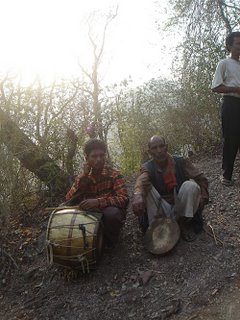 (not the polished wooden drumsticks we use). The groom on his donkey, the donkey-minder who stayed behind to whack the animal every once in a while, all the groom's family and future in-laws and ourselves (the esteemed VIP foreign guests with our fancy cameras) wended our way slowly up the hillside. The tinsel marriage turban kept slipping down the groom's perspiring forehead and he adjusted it repeatedly.
(not the polished wooden drumsticks we use). The groom on his donkey, the donkey-minder who stayed behind to whack the animal every once in a while, all the groom's family and future in-laws and ourselves (the esteemed VIP foreign guests with our fancy cameras) wended our way slowly up the hillside. The tinsel marriage turban kept slipping down the groom's perspiring forehead and he adjusted it repeatedly.The views were stunning ones of the Garhwali Himalayan foothills and the turquoise Ganges below. It was thankfully breezy, though hot. I wondered why there were not more trees. Someone told me a few weeks ago that these used to be teakwood forests before the British cut them all down, but that was sixty years ago; more trees should have grown by now.
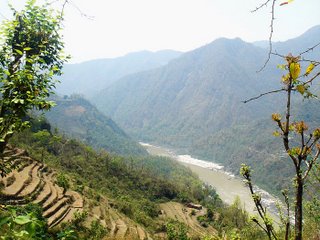 When we finally reached the terraced hillside home of the bride, the entire village seemed to have turned out for the occasion - waiting expectantly for the approach of the drummers. Little children, families and elders all stood on the terraces as though they were stadium bleachers - boys perched in the trees like monkeys. The groom was greeted under a special archway erected from stalks of banana trees. The women of the bride's family, and the rent-a-pundit priests, had to remove any evil eye from him by greeting him with a ceremonial flame (ghee lamp on a tray), incense and Sanskrit chanting. They repeatedly daubed his forehead (actually, the tinsel mar
When we finally reached the terraced hillside home of the bride, the entire village seemed to have turned out for the occasion - waiting expectantly for the approach of the drummers. Little children, families and elders all stood on the terraces as though they were stadium bleachers - boys perched in the trees like monkeys. The groom was greeted under a special archway erected from stalks of banana trees. The women of the bride's family, and the rent-a-pundit priests, had to remove any evil eye from him by greeting him with a ceremonial flame (ghee lamp on a tray), incense and Sanskrit chanting. They repeatedly daubed his forehead (actually, the tinsel mar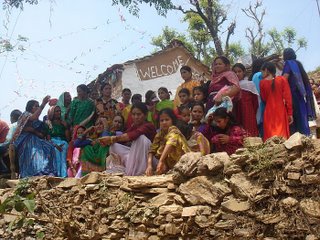 riage crown covered his forehead completely) with red tikka and turmeric paste dots before leading him into the roped-off area of the yard that had been designated for the wedding - and of course, as seating for us VIPs. The villagers, who'd probably known the bride all her life, had to make do sitting on the parched earth and dried grass. We were given the prestigious moulded plastic chairs under a homemade awning (bed sheets stretched between wooden poles) to protect our fair skin from the sun. Only we foreigners and the bride and groom's family were important enough to be seated here.
riage crown covered his forehead completely) with red tikka and turmeric paste dots before leading him into the roped-off area of the yard that had been designated for the wedding - and of course, as seating for us VIPs. The villagers, who'd probably known the bride all her life, had to make do sitting on the parched earth and dried grass. We were given the prestigious moulded plastic chairs under a homemade awning (bed sheets stretched between wooden poles) to protect our fair skin from the sun. Only we foreigners and the bride and groom's family were important enough to be seated here.Naturally I sensed I was missing the real photo-ops and got up to look around. The house itself is a handmade one of wood and mud. It had been specially decorated with traditional white striping reading "Swagatham"(welcome) and "Shubh Vivaha" (good wedding). The lower story had two low-roofed, dark rooms and a family of water buffalo living under the porch. The upper storey window was crowded with demure village lasses who beckoned me shyly to come visit.
The bride doesn't have the same problem of avoiding the evil eye, usually because she is seque
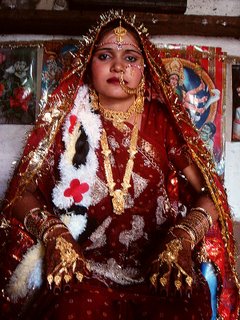 stered the day of the wedding. Inside the mud house, the bride sat cowering, covered up in tinsel and so much gold jewellery that her hands looked like metallic claws. You may think cowering is a judgmental word, but that's exactly what she was doing - trembling, in fact. The heat was unbearable, at least to me, in the top floor of the mud house but the bride sat motionless under her veil of red and shiny gold, head demurely downcast. When asked to raise her head for my photos, though, she met my camera with an impressively stoic and strong gaze.
stered the day of the wedding. Inside the mud house, the bride sat cowering, covered up in tinsel and so much gold jewellery that her hands looked like metallic claws. You may think cowering is a judgmental word, but that's exactly what she was doing - trembling, in fact. The heat was unbearable, at least to me, in the top floor of the mud house but the bride sat motionless under her veil of red and shiny gold, head demurely downcast. When asked to raise her head for my photos, though, she met my camera with an impressively stoic and strong gaze.Despite the presence of electricity, there was no fan and no one fanned the bride (a sign of honour) - instead the grandmother sitting nearby picked up a piece of cardboard and fanned me. I guess I was more important than the bride, in some way. A young man came to the door and offered a glass of RoohAfza or cool rosewater, the same colour as the bride's red sari. Cool water of any kind was a real commodity there and I wondered how in the world they had refrigerated it. It turned out that someone had carried (!) a cooler of big, old-fashioned ice blocks all the way up there for just such frivolities.
Meena was incredibly beautiful, even to someone who has spent three years looking at Indian women. I had seen the groom and he was nice looking, b
 ut he was getting a real deal with this girl. Unfortunately no one in the house spoke a word of English (but they did understand when I said "So beautiful!"), so they could not answer my questions about the marriage situation. Did Meena's family have to pay a dowry? had she ever seen or met the groom previously? How old was Meena? what was her education? What was the groom's profession?
ut he was getting a real deal with this girl. Unfortunately no one in the house spoke a word of English (but they did understand when I said "So beautiful!"), so they could not answer my questions about the marriage situation. Did Meena's family have to pay a dowry? had she ever seen or met the groom previously? How old was Meena? what was her education? What was the groom's profession?Eventually a young man came along who spoke enough English to answer some of my questions. He denied that the family had paid a dowry; and while I was not sure I believed him, it did seem that the groom's family should be paying up in order to get such a remarkable girl. Meena had finished high school. The groom's family owned a restaurant down in Ram Jhula and had a big, pucca house (one made of concrete with more than one storey). They had become engaged through the network of other families in their caste, namely, the Garhwali Thakur caste - something like Kshatriyas, the warrior caste of old. Long ago, perhaps three hundred years before, their forebears had come to the Garhwal mountains from Rajasthan, known for its warrior tradition.
Meen
 a had met the groom once before - of course, with both of the families present. This was during the ritual called "going to see the girl." The groom's entire family trekked up the mountain to "view" Meena. At this point she had to be on her best behaviour, being very deferential, never looking strange men in the eye and probably serving tea to her potential in-laws. I couldn't ascertain whether the bride and groom had ever had a confidential conversation, but it seemed unlikely.
a had met the groom once before - of course, with both of the families present. This was during the ritual called "going to see the girl." The groom's entire family trekked up the mountain to "view" Meena. At this point she had to be on her best behaviour, being very deferential, never looking strange men in the eye and probably serving tea to her potential in-laws. I couldn't ascertain whether the bride and groom had ever had a confidential conversation, but it seemed unlikely.Other families have told me that the girl's behaviour at this point ("Going to meet the Girl") is critical. How does she treat the family members? Is she well-behaved? (I would imagine this means, does she do as she's told?) It is strictly a buyer's market; Meena was the fourth daughter and I would imagine the parents were relieved at finding a groom that didn't ask too much dowry.
To be continued










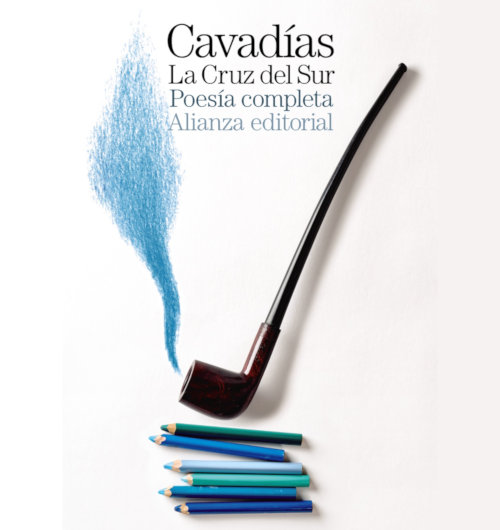



1 comment:
VIEWER MAIL
Robert in northern California writes:
You are correct in your assessment of the Blogger photo uploads... it is not working!
....
Dear Robert:
Sincere thanks for verifying. At least it's not personal!
Post a Comment